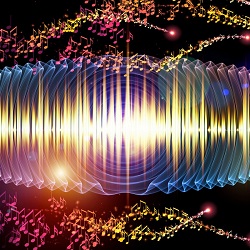Highly pitched sound could be used to make molecules dance on a surface and help us discover their identity.
What happens with molecules when a liquid comes in contact with a solid surface is crucial in many areas of nanotechnology, such as catalysis, developing new energy materials and biosensing. Nuclear magnetic resonance (NMR) is the principle behind nuclear magnetic imaging (MRI) and occurs when atoms in a strong magnetic field are exposed to radio waves. The atoms can absorb these waves and leave footprints characteristic to their identity. A versatile and powerful technique emerged from this principle, to study both liquids and solids (including deep in our brains in the case of MRI), and yielding very detailed structural information.
However, due to its poor sensitivity, current NMR techniques are not great for studying thin layers of water mixed with molecules spread onto a solid surface. In this project, I’m investigating the possibility of using acoustic waves to increase the visibility of these molecules.
A thin quartz crystal, similar to the ones used in watches, produces sound and creates ripples when immersed in water. These vibrations make the molecules which are close to the surface dance in the exact rhythm of the crystal. If this rhythm, which is called oscillating frequency, has a specific value, atomic nuclear spins flip over and a footprint of the molecules can be recorded. The challenge lies in determining whether these nuclei actually flip over when they are subjected to sound and what are the ideal conditions. To achieve this I have designed two experimental set-ups using and preliminary experiments show that there is an interaction between sound and nuclear spins. The source of this interaction still remains a mystery so far, but experiments and calculations are slowly shedding some light on this new concept defined as Nuclear Acoustic Resonance.
Alexandra Grigore
NanoDTC PhD Student Cohort 2012
Chemical Engineering and Biotechnology
Cover Image- Flow Machines

